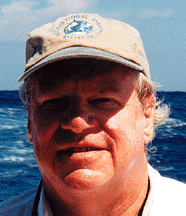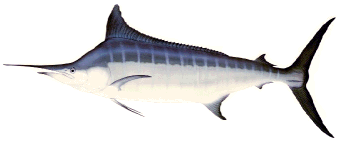

The population status of most "large coastal" shark species of the U.S. Atlantic coast (39 species) is less well documented than those for Atlantic swordfish, other billfish and tunas described elsewhere on this website.� But, they appear to have declined even more severely and in a shorter period of time.� The populations of many "large coastal" sharks appear to have declined from 50 to 80 percent between the early 1970s and today.� These include many familiar species such as tiger, hammerheads, bull, lemon, blacktip, sandbar, nurse and great white. It is estimated that the large coastal shark group has declined from roughly 9-11 million fish in 1974 to an estimated 1-2 million fish in 1998 or about 30-36 percent of the population size needed to produce the maximum sustainable yield (MSY).�The status of the "pelagic" shark group is unknown. It includes the makos, porbeagle and blue shark.�
In 1997, NMFS cut the commercial quota and recreational bag limits in half for the large coastal group and prohibited the landing of five additional species (now totaling 21), but there is still no evidence of a recovery of any.� In 1997, fishing pressure was still more than six times that which these shark populations can sustain.�
������ ����������������������������������� They May NEVER Recover
Sharks do not have the capability to repopulate quickly.� They are slow to reach maturity and when they do they produce only a few young per year.� They simply cannot tolerate high rates of mortality.� If all fishing were to cease, modeling results from the 1998 stock assessment indicate that there is less than a 50:50 chance that these shark populations could recover to their MSY level (the "sustainable" level or that which responsible fishery managers would never let a population slide below) even after 30 years!

Longliners fish most heavily during the periods when the moon is brightest.� So, this real-time image of the moon phase shows when the kill of swordfish is greatest.� However, it also shows when the kill of blue marlin, white marlin, sailfish, sharks, tunas, sea turtles, marine mammals and a host of other marine life is also greatest - even though many are not even targeted.�� For more, see the link below.
Index
Atlantic Blue Marlin - 3 pages
Pacific Blue Marlin - 4 pages
Giant Bluefin Tuna - 6 pages
Grander Bluefin on Stand-Up
World Record Bluefin
Black Marlin - 3 pages
Swordfish - 3 pages
Spearfish
White Marlin - 2 pages
Large Sharks
Sailfish
Yellowfin Tuna
Bigeye Tuna
Severity of Atlantic Population Declines
The Facts - Headed for Extinction
White Marlin and Blue Marlin
Bluefin Tuna
Swordfish
Bigeye Tuna
Sailfish
Daily "Kill-o-Meter"
Articles about Big Game Fish and Fishing
"Hunting Giants"
"Grander Hunting"
"Those Magnificent Giants"
"Going, Going, Gone"
"Headed for Extinction"
"Atlantic Hot Spots"
![]()
Chambers and Associates
Description
List of All Links on the Website
Home


Jim Chambers

9814 Kensington Parkway
Kensington, Maryland 20895
(T) (301) 949-7778�� (Fax) (301) 949-3003